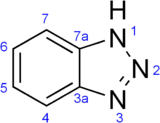
| |

| |
| Names | |
|---|---|
| Preferred IUPAC name
1H-1,2,3-Benzotriazole | |
| Other names
1H-Benzotriazole; 1,2,3-Benzotriazole; BTA; BtaH
| |
| Identifiers | |
3D model (JSmol)
|
|
| ChEBI | |
| ChEMBL | |
| ChemSpider | |
| ECHA InfoCard | 100.002.177 |
| EC Number |
|
PubChem CID
|
|
| RTECS number |
|
| UNII | |
CompTox Dashboard (EPA)
|
|
| |
| |
| Properties | |
| C6H5N3 | |
| Molar mass | 119.127 g·mol−1 |
| Appearance | White solid |
| Density | 1.36 g/mL[1] |
| Melting point | 100 °C (212 °F; 373 K)[2] |
| Boiling point | 350 °C (662 °F; 623 K)[2] |
| 20 g/L[2] | |
| Acidity (pKa) | 8.2[3][4] |
| Basicity (pKb) | > 14[4] |
| Hazards | |
| GHS labelling: | |
 
| |
| Warning | |
| H302, H319, H332, H411, H412 | |
| P261, P264, P270, P271, P273, P280, P301+P312, P304+P312, P304+P340, P305+P351+P338, P312, P330, P337+P313, P391, P501 | |
| Related compounds | |
Related compounds
|
Benzimidazole, Tolyltriazole |
Except where otherwise noted, data are given for materials in their standard state (at 25 °C [77 °F], 100 kPa).
| |
Benzotriazole (BTA) is a heterocyclic compound with the chemical formula C6H5N3. Its five-membered ring contains three consecutive nitrogen atoms. This bicyclic compound may be viewed as fused rings of the aromatic compounds benzene and triazole. This white-to-light tan solid has a variety of uses, for instance, as a corrosion inhibitor for copper.[5]
- ^ "1H-Benzotriazole (CAS 95-14-7)". Archived from the original on 2020-10-24.
- ^ a b c 1H-Benzotriazole Archived September 27, 2007, at the Wayback Machine, SRC PhysProp Database
- ^ Katritzky, A. R.; Rachwal S.; Hitchings G. J. (14 January 1991). "Benzotriazole: A novel synthetic auxiliary". Tetrahedron. 47 (16–17): 2683–2732. doi:10.1016/S0040-4020(01)87080-0.
- ^ a b Katritzky, A. R. "Adventures with Benzotriazole" (PDF). Lecture presented at various locations in 2002. Florida Center for Heterocyclic Compounds. Archived from the original (PDF) on 26 April 2012. Retrieved 23 November 2011.
- ^ "1,2,3-BENZOTRIAZOLE | CAMEO Chemicals | NOAA". cameochemicals.noaa.gov. Retrieved 2023-01-17.